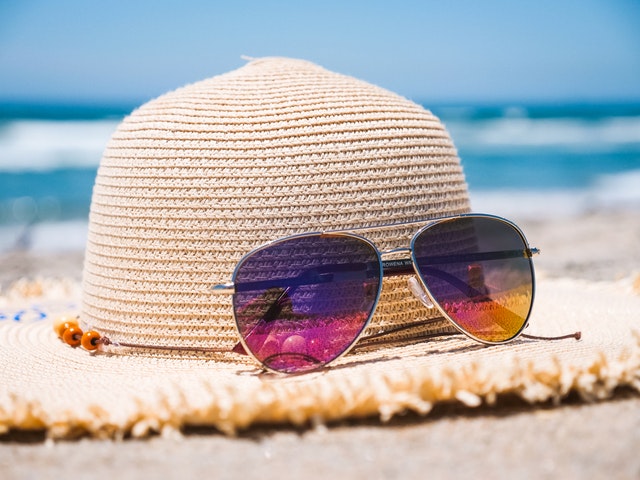There are many different types of sunscreen on the market, but which ones are best for oily or acne-prone skin types?
Sunscreen is a great tool to help protect against sun damage, which can increase the risk of sunburns, early skin aging, and skin cancers.
The American Academy of Dermatology (AADA) recommends that everyone use a broad-spectrum sunscreen with a sun protection factor (SPF) rating of 30 or higher every day that they go outside, even on cloudy days.1
The AADA also emphasizes the importance of using enough sunscreen to fully cover any exposed areas of the body and reapplying every two hours when outdoors.1
Additionally, sunscreen is not the only way to prevent sun damage; dermatologists recommend wearing sun-protective clothing, hats, and sunglasses, as well as seeking shade during the hours when the sun’s rays are strongest.1
Despite its benefits, one study by the Centers for Disease Control and Prevention (CDC) found that the majority of participants did not use sunscreen regularly.2,3
In this study, participants reported a variety of reasons for not using sunscreens, such as inconvenience, low perceived risk of sun damage, cost, and more.2,3
Some people may also not enjoy the feeling of wearing sunscreen, as some sunscreens may feel heavy or greasy on the skin.
This is not ideal for people with oily skin types, and this may prevent them from using sunscreens regularly and properly.
Moreover, some sunscreens can be comedogenic, or pore-clogging, and this can be a deterrent for those with acne-prone skin types.
Regardless of skin type, sun protection is still important, as it can help prevent sun damage and its complications.
Additionally, retinoids and some other acne medications can make people more susceptible to sun damage, so wearing sunscreen is particularly important when using these.4
Fortunately, not all sunscreens are created equal, and some formulations may be particularly suited for oily skin types.
One important factor to consider, particularly for those with a skin type that is both oily and acne-prone, is the comedogenicity of a product.
Comedogenicity refers to a topical product’s ability to clog pores, and it is generally ranked on a scale of zero to five; a score of zero means the product will not clog pores at all, whereas a score of five means that the product is very likely to clog pores.5
Some ingredients in cosmetics and skincare are especially considered to be comedogenic, including isopropyl isostearate, algae extract, benzaldehyde, and some oils such as coconut, palm, and linseed oils.5,6
Some ingredients with lower comedogenicity include glycerin, hyaluronic acid, aloe vera, cetyl alcohol, and many more.5,6
Many of these ingredients are still hydrating to the skin as they help prevent trans-epidermal water loss, and even oily skin can often benefit from using hydrating ingredients in a skincare routine.
However, they are much less likely to clog pores. Since clogged pores are related to the formation of acne lesions, people with oily and acne-prone skin may want to look for sunscreens labeled “non-comedogenic”, as this indicates a score of two or less on the comedogenic scale.5
Some sunscreen ingredients may also help regulate the production or levels of sebum in the skin.
Sebum, commonly referred to as the body’s natural oils, is a mixture of lipids secreted by the sebaceous glands.7
It is very important, as it helps prevent water loss and helps protect the skin from outside stressors.7
However, too much sebum can be an issue, as it can make the skin feel excessively oily, and it may be associated with acne for some people.7
Niacinamide, which is a derivative of vitamin B3, may help reduce excess sebum on the surface of the skin and provide a variety of other benefits as well.8
Salicylic acid is another potentially beneficial ingredient, as one of its potential benefits is regulating the excessive sebum production associated with acne vulgaris.9
If recommended by a doctor or other healthcare professional, incorporating these ingredients in sunscreen or in other steps of a skincare routine may be beneficial for some.
Ultimately, sunscreens are an important part of sun protection, and wearing a sunscreen that you like can help you remember to use it regularly.
This article is not medical advice, and it is not intended to diagnose or treat any specific condition.
Consult a doctor or other qualified healthcare provider for your unique needs.
References:
- American Academy of Dermatology Association (n.d.) Sunscreen FAQs. Accessed 2022, February 22, from https://www.aad.org/public/everyday-care/sun-protection/sunscreen-patients/sunscreen-faqs
- Holman, D.M., Berkowitz, Z., Guy, G.P., et al (2015, July). Patterns of sunscreen use on the face and other exposed skin among US adults. J Am Acad Dermatol 73(1): 83-92.e1. Doi: 10.1016/j.jaad.2015.02.1112
- National Cancer Institute (2015, June 1). Most American Adults Do Not Use Sunscreen Regularly. National Institutes of Health. Accessed 2022, February 22, from https://www.cancer.gov/news-events/cancer-currents-blog/2015/no-sunscreen
- Stiefel: A GSK company (2021, February 9). Product Monograph. GlaxoSmithKline Inc: Mississauga, Ontario. Accessed 2022, February 24, from https://ca.gsk.com/media/6123/stieva-a.pdf
- Ghani, H., Rahman, R.K., Liu, K., et al; The National Society for Cutaneous Medicine (2021, September). An investigation of makeup ingredients and their effects on acne cosmetica with dermatologic practice recommendations. In-Depth Review 5(5). Accessed 2022, February 25, from https://scholar.archive.org/work/d75rd3tstfffzlo4dasiu3y34u/access/wayback/https://jofskin.org/index.php/skin/article/download/1289/pdf
- Narayanan, V. (2020). Holistic Skin care and selection of skin care products in acne. Arc Clin Exp Dermatol 2(1): e101. Accessed 2022, February 25, from https://www.yumedtext.com/files/publish/published-pdf–6-ACED-e101.pdf
- Picardo, M., Ottaviani, M., Camera, E., et al (2009, March-April). Sebaceous gland lipids. Dermatoendocrinol 1(2): 68-71. Doi: 10.4161/derm.1.2.8472
- https://web.archive.org/web/20190309093418id_/http://pdfs.semanticscholar.org/f721/75d6a644a69123d1158249115e558e2c5888.pdf
- Lu, J., Cong, T., Wen, X., et al (2019, July). Salicylic acid treats acne vulgaris by suppressing AMPK/SREBP1 pathway in sebocytes. Exp Dermatol 28(7): 786-794. Doi: 10.1111/exd.13934.
Photo by Kindel Media from Pexels



